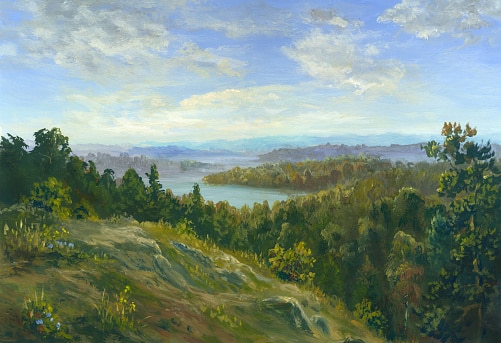
Impressionism emerged during a time of great social, political, and artistic change in France. It was a direct response to the rigid academic system that dictated the subject matter and style of art at the time. Artists began seeking new avenues of expression, rejecting the established norms and forms. This rebellious spirit of experimentation laid the foundation for Impressionism.
The term “Impressionism” was coined by art critic Louis Leroy in 1874, after Claude Monet’s painting “Impression, Sunrise” caused quite a stir at an exhibition. Leroy’s critical and dismissive response inadvertently became the name of a movement that would redefine art.
Impressionist artists sought to capture the ever-changing world around them, with a focus on light, color, and movement. They painted en plein air (outdoors) to capture the fleeting effects of natural light and atmosphere. This departure from traditional studio painting led to a more spontaneous and immediate style.
Impressionist art is characterized by several distinct features that set it apart from traditional academic painting.
One of the most notable aspects of Impressionism is the emphasis on capturing the fleeting effects of light and atmosphere. This is achieved through the use of broken brushstrokes and an unblended application of paint. This techniques creates a sense of movement and immediacy in the artwork.
Another characteristic of Impressionist art is the vibrant and sometimes unconventional use of color. Rather than using muted tones and strict color schemes, Impressionist artists opted for bold and expressive hues that accurately represented the vibrant world around them.
Furthermore, Impressionist artists often painted en plein air, which allowed them to directly observe and capture the ever-changing outdoor scenes. This choice to work directly from nature added a sense of spontaneity and authenticity to their paintings.
The Impressionist art movement was defined by a group of groundbreaking artists who challenged the conventions of their time and left a lasting impact on the art world.
One of the key founders of the movement was Claude Monet, whose vibrant and expressive brushwork captured the essence of light and atmosphere like no other. His series of Water Lilies and Haystacks are considered iconic examples of Impressionist art and continue to inspire artists today.
Another prominent figure in Impressionism was Edgar Degas, known for his depictions of ballet dancers and everyday life. Degas pushed the boundaries of composition and perspective, often capturing his subjects from unusual angles and cropping his compositions in unconventional ways.
Berthe Morisot, the only female member of the Impressionist group, brought a unique perspective to the movement. She focused on intimate and domestic scenes, painting women and children with a sensitivity and empathy that set her apart from her male counterparts.
These are just a few examples of the many talented artists who shaped the Impressionist movement. Their bold experimentation and commitment to capturing the fleeting moments of life revolutionized the art world. This movement continues to inspire artists and art enthusiasts alike.
The influence of Impressionism can be seen in various art movements that followed. These include Post-Impressionism, Fauvism, and even abstract art. The focus on capturing the essence of a scene or subject, the vibrant use of color, and the loose brushwork continue to resonate with artists as they strive to express their own interpretations of the world around them.
Impressionism revolutionized the art world and continues to inspire artists and art enthusiasts to this day. The movement’s emphasis on capturing fleeting moments and the changing effects of light fundamentally challenged the established norms of academic art. By rejecting the rigid rules and formal techniques of the past, Impressionist painters opened the door to new possibilities. Thus paving the way for the development of modern and contemporary art.
It has left an indelible mark on the art world, challenging conventions and inspiring generations of artists. Its vibrant and dynamic approach to capturing the beauty of the everyday has ensured its enduring legacy and continues to captivate audiences worldwide. So, take a moment to appreciate the brilliance of Impressionist art and discover its timeless charm that still enchants us today.